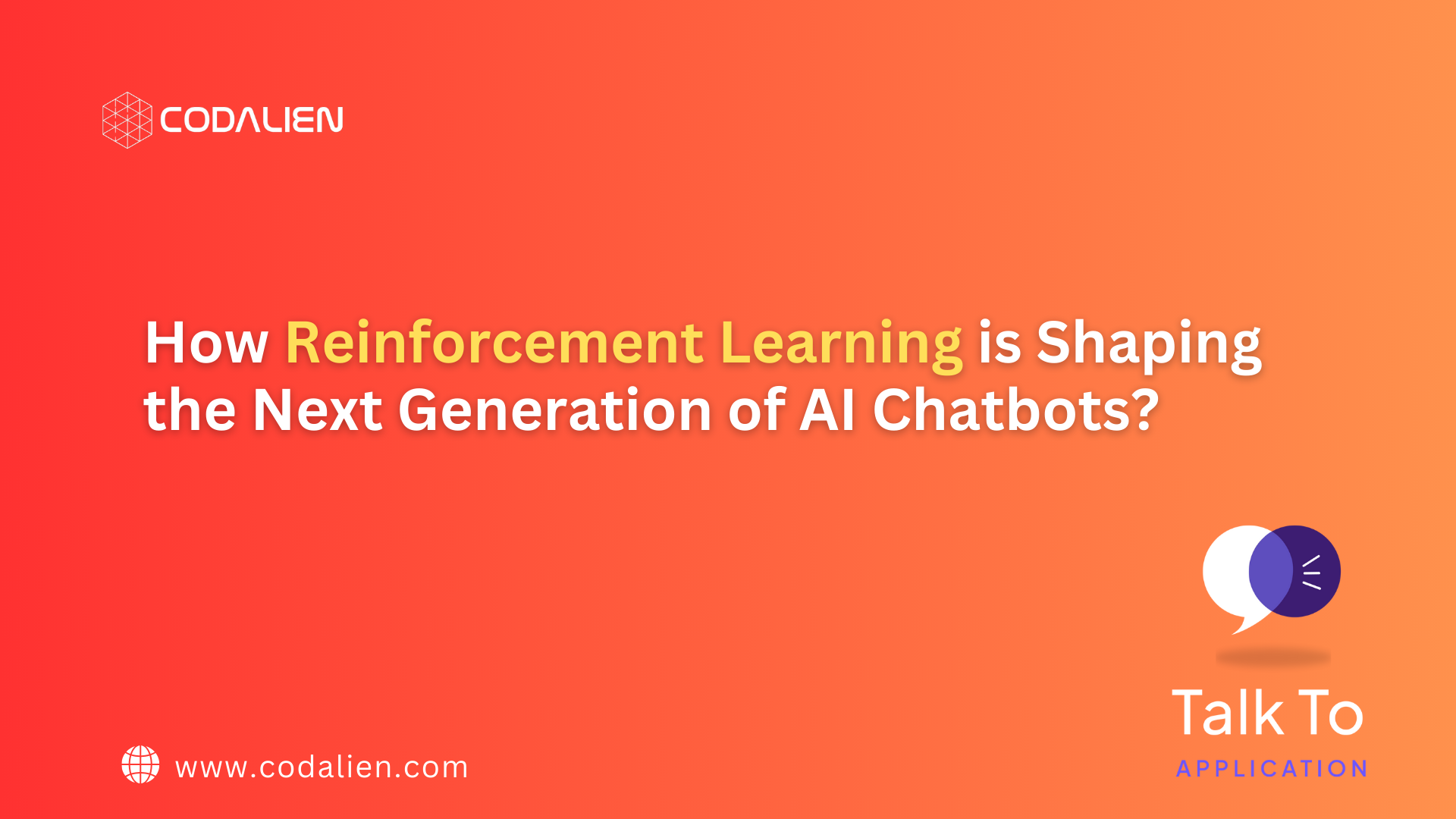AI chatbots are no longer just about answering “What are your working hours?” or guiding users through FAQs. They’re becoming conversation partners, problem solvers and even reporting managers and sales agents. What’s driving this transformation? Enter Reinforcement Learning (RL)—a type of machine learning that’s changing the way chatbots think, learn, and respond.
At Codalien Technologies, we’ve integrated RL into our conversational AI systems (Talk-To applications and SellonChat Shopping Assistant) to create smarter, more human-like chatbots that elevate user experiences and drive business success. Reinforcement Learning makes the latest generation of chatbots intuitive, adaptable, and insightful. Let’s unpack how this technology is reshaping conversational AI and its potential for businesses and users alike.
What Makes Reinforcement Learning Special?
At its core, Reinforcement Learning is about learning by doing. Imagine teaching a dog new tricks—every time it fetches a ball, you reward it with a treat. RL works similarly. Here, the chatbot (the “agent”) interacts with users (its “environment”), learns from these interactions, and adjusts its behavior based on rewards (positive outcomes) or penalties (negative outcomes).
Unlike traditional chatbots, which are programmed with rigid scripts or static responses, RL-powered bots evolve. They adapt to real-world scenarios by continuously learning from user interactions. Think of it as upgrading from a parrot to a guide dog—one can repeat what you say, while the other learns to respond meaningfully and helpfully.
Why RL-Powered Chatbots Are a Big Deal?
Here’s how RL is giving chatbots a much-needed boost:
1. Conversations That Make Sense
Gone are the days of chatbots replying with, “I’m sorry, I don’t understand your question.” With RL, chatbots learn to handle ambiguous or multi-layered queries. They consider the conversation’s context, interpret nuances, and keep the dialogue flowing.
💡 Example: A chatbot assisting with technical support can now ask follow-up questions like, “Did you try restarting your modem?” rather than just pointing to a generic troubleshooting page.
2. Tailored to You, Over Time
Reinforcement Learning allows AI chatbots to recognize patterns in user behavior and preferences. This means the chatbot you interact with tomorrow will be a little smarter than the one you spoke to today.
🎯 Real-life Impact: An e-commerce chatbot might learn that you’re a tech enthusiast who prefers detailed specs over flashy promotions. The next time you’re browsing for gadgets, it will recommend products with detailed tech specs, cutting out the noise.
3. Better Decision-Making
RL isn’t just about responding; it’s about responding better. By weighing options and predicting outcomes, chatbots can choose replies that optimize both user satisfaction and business goals.
🛠️ Example: A banking chatbot can decide whether to guide you through a loan application or escalate your query to a human agent, depending on how complex your question is.
4. They Actually Learn from Feedback
Every thumbs-up or thumbs-down on a chatbot’s response helps it learn. For example, positive interactions are rewarded, while negative ones prompt course corrections. In other words, it’s like having a teacher available 24/7 to refine the chatbot’s skills.
📊 Fact: Studies show that RL-based chatbots improve user satisfaction rates by 25% within the first three months of deployment.
Where RL Chatbots Are Already Making Waves?
1. Customer Support
RL-powered bots are the major tool to deliver modern customer support. They handle everything from simple FAQs to complex troubleshooting, saving businesses time and money while keeping customers happy.
🔍 Did You Know? Companies using RL chatbots have seen a 30% drop in average resolution time for support tickets.
2. E-Commerce
In online shopping, RL-based bots don’t just answer questions—instead, they guide users through their buying journey. For instance, from recommending products to upselling based on preferences, these chatbots drive sales just like a pro salesperson.
3. Healthcare Assistance
Imagine a chatbot that helps patients schedule appointments, track medications, and even provide mental health support. RL chatbots in healthcare are learning to balance empathy with efficiency, making them invaluable tools.
The Challenges Behind the Scenes
While RL is a game-changer, it’s not without its hurdles:
- Data-Hungry: RL needs vast amounts of data to learn effectively, which can be challenging for niche industries.
- High Computational Costs: Training an RL chatbot isn’t cheap—it requires powerful hardware and lots of time.
- Ethical Concerns: Chatbots need to be trained responsibly to avoid bias and ensure fair treatment for users.
What’s Next for RL Chatbots?
The future of RL-powered chatbots is bright. Imagine bots that can:
- Understand multiple inputs—text, voice, and even images.
- Predict user needs before they even ask a question.
- Scale effortlessly across languages, platforms, and industries.
According to experts, by 2030, over 80% of customer interactions will involve RL-powered conversational AI.
How Codalien Technologies is Leading the Charge?
At Codalien Technologies, we specialize in building RL-powered chatbots tailored to meet diverse business needs. Whether you’re an e-commerce platform looking to personalize customer experiences or a healthcare provider seeking efficient patient interaction tools, our expertise ensures your chatbot not only performs but excels.
What’s Next for RL Chatbots?
The future of RL-powered chatbots is promising. They are expected to:
- Handle multi-input queries involving text, voice, and even images.
- Predict user needs before being asked.
- Scale seamlessly across industries, languages, and platforms.
According to Gartner, by 2030, over 80% of customer interactions will involve RL-powered conversational AI.
Why Should You Care?
If you’re a business, RL-powered chatbots are more than just a trend—they’re necessary. They improve customer experiences, reduce operational costs, and adapt to changing user demands.
If you’re a user, get ready for a world where chatbots feel less like bots and more like helpful assistants who understand what you need.
At Codalien Technologies, we’re at the forefront of this transformation. Whether you’re looking to deploy an AI chatbot for your business or want to explore how RL can elevate your existing systems, we’re here to help.
Let’s build the chatbot your customers deserve—one that learns, adapts, and evolves every step of the way.

